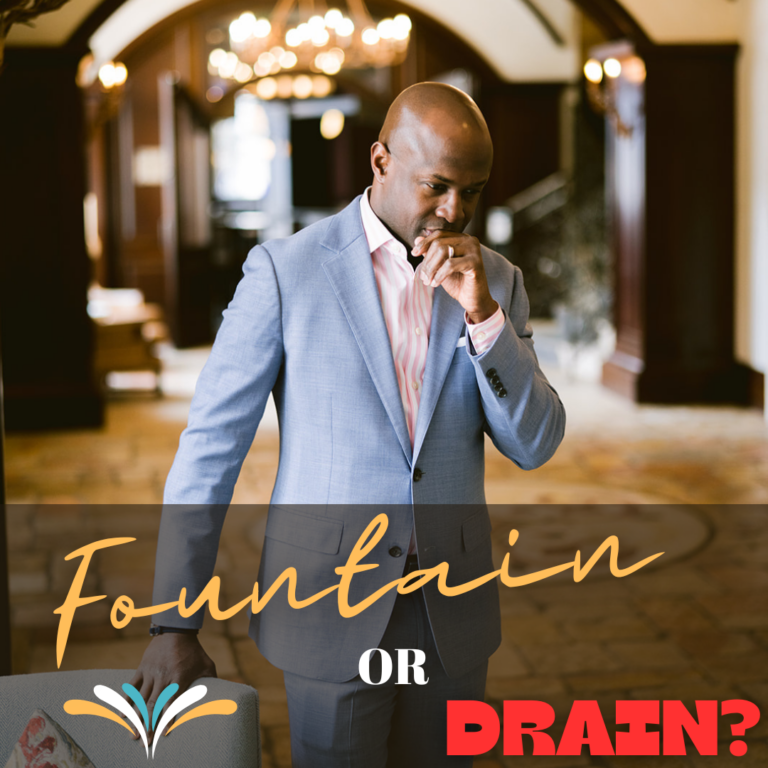
Are You a Fountain or Drain?
Fountains give nourishment. Drains take it away. Am I a fountain or a drain? That is the essential question that each of us should ponder
Share this post:
Engaging your customers is not rocket science. With all of the articles, books, blogs, videos and conferences that are available, it can seem that creating an engaging service experience requires a lifetime worth of training. Not true. If you asked me, “how can we improve our service tomorrow?”, I would advise you to begin with your touchpoints. I’m sure that you have heard this word before, but I’ll go ahead and define it anyway. A touchpoint is any moment of interaction between two parties. If I pass you in the hallway, that’s a touchpoint; when you answer the phone, that’s a touchpoint; when you open the door for someone, that’s a touchpoint. If you think about it, there are literally hundreds of touchpoints in a typical workday. Now here’s the interesting part; every touchpoint has either a deposit or a withdrawal. If I’m an employee at Company X, and I pass two customers in the hallway without acknowleding them, that’s a withdrawal. If I give eye contact and smile, that’s a deposit. Better yet, if I give eye contact, smile, stop, give a greeting, and offer assistance, then that’s an even bigger deposit. This same concept works for every touchpoint, every time.
So how do you identify your touchpoints? The fastest way is to sit in your office and brainstorm by yourself. Unfortunately, you would be missing a tremendous opportunity to involve your staff in matters that directly affect them. If the goal of identifying touchpoints is to engage your customers, then you must first engage those that serve your customers. While you’re at it, get your team’s input on deposits and withdrawals for each touchpoint as well. Trust me, they will respect you for asking them AND you would have just made a big deposit to your staff! If you haven’t guessed by now, deposits equal more engagement and withdrawals equal less engagement.
Back in 2006, I was on board a transatlantic flight from Paris to DC. Since these flights are at least six hours long, airlines tend to offer beverage service at multiple times…especially for those of us who fly coach. When the flight attendants were on their third cycle of beverage service, one passenger asked a flight attendant, “So what drinks do you have?” The attendant looked at the passenger and said, “the same drinks we had 2,000 miles ago!” If there was ever a candidate for the “king of all withdrawals”, this was it. The sad part is that I was four rows back and could hear the flight attendant clearly. That means the attendant’s statement was a withdrawal for everyone else on the flight that could hear him. The key business point here is that most passengers will not remember the attendant who made the withdrawal, but they will remember the airline. Learning point: All it takes is one employee, one touchpoint, and one withdrawal to lose a customer. On the other hand, one employee, one touchpoint, and one deposit can create an engaged customer.
Just last week, I stayed at a Springhill Suites hotel in Baton Rouge, LA and barely missed the breakfast buffet by a few minutes. As the buffet attendant was cleaning up, she saw the disappointed look on my face when I approached. She told me that she would be happy to get me something from the back. So I asked for cereal with skim milk, and she said that she would return with the cereal right away. The attendant returned with two boxes of cereal, skim milk, and a big smile. She then asked if there was anything more she can do, and when I said no, she wished me a pleasant day. I did not feel like I was an interruption of her job, but the purpose of it. As we examine this touchpoint, there were multiple deposits made: offered to get breakfast, brought two types of cereal, offered additional assistance, and wished me a pleasant day. The beautiful part is that the entire transaction took less than 5 minutes, and this article will eventually be seen by thousands of readers. Learning point: Multiple deposits encourage free word-of-mouth advertising. In the same touchpoint, multiple withdrawals could have easily been made. The buffet attendant could have pretended not to see me. She could have fled to the back when she saw me coming. Or she could have told me that the buffet was closed, and there was nothing she could do about it. All it takes is one touchpoint.
My challenge to you is commit to identifying your department’s touchpoints, and be sure to involve your staff in the process. Then, as a team, brainstorm multiple deposits that can be made for each touchpoint (Hint: There are members on your team already making excellent deposits. Use this as an opportunity to solicit and share them with the entire team). Be sure to include a few withdrawals as well. It’s amazing how many people make withdrawals and don’t even know it.
Let this be your year for maximizing every touchpoint, for every customer, at every possible moment. Soon you will have a legion of engaged customers who can’t wait to tell others about your exceptional service, and how you were able to engage them one touchpoint at a time.

Fountains give nourishment. Drains take it away. Am I a fountain or a drain? That is the essential question that each of us should ponder

Yes. Three letters. Small, but mighty. There is so much that is written about boundaries and saying “no.” Make no mistake, boundaries are essential. They